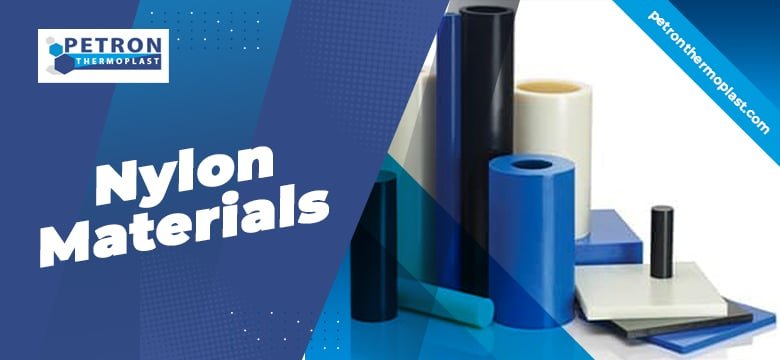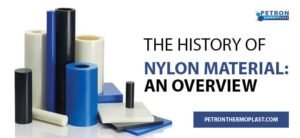All About Nylon Materials and The History
The first synthetic nylon was created in 1935 by American scientist Wallace Carothers, who was then working at the DuPont research centre in Delaware. Nylon is a synthetic thermoplastic linear polyamide, which is a large molecule whose parts are connected by a certain sort of bond. Wallace created what is officially referred to as Nylon 66. (still one of the most common variants). During World War II, when natural resources like silk, rubber, and latex were in a much shorter supply, demand for synthetic materials in general and Nylon in particular increased.
Nylon materials are utilised in many different ways, including as clothing, as rope or thread, as reinforcement in rubber products like automobile tyres, and in a large number of injection-moulded auto and machinery parts. It is incredibly durable, somewhat resistant to abrasion and moisture absorption, elastic, chemically resistant, robust, and simple to clean. A frequent replacement for low-strength metals is nylon. Its strength, temperature resistance, and chemical compatibility make it the plastic of choice for components in cars’ engine compartments.
Additionally, a wide range of chemicals may be mixed with nylon to create several variations with noticeably different material qualities. Check out this composite gear composed of carbon and nylon.
The terms “PA” (e.g., PA 6 or PA 6/66) are frequently used to refer to nylon, which is most frequently seen in the colours black, white, and its natural hue (off-white or beige). Nylon 6/6 is arguably the most often used type for technical purposes. Nylon 6/6 is a good material for both injection moulding and 3D printing and may be extruded (melted and driven through a die). It has a high melting point, giving it a great alternative to metals in settings with high temperatures (e.g., under the hood of a vehicle). The material’s disadvantage is that its impact strength is rather low (even when compared to other plastics; see the chart below).
The following illustration compares Nylon’s impact resistance to those of other widely used polymers including ABS, polystyrene (PS), and polycarbonate (PC). It should be noted that Nylon may be “conditioned” to increase its impact strength. It is crucial to evaluate the material qualities of the specific Nylon material you are employing because of this and the simplicity with which Nylon may be mixed with other materials to increase its strength.
Why is Nylon used so often?
Because of its naturally low friction characteristics, Nylon materials are frequently used in gears, bushings, and plastic bearings. Since low friction is the main factor, we normally advise acetal above nylon as the slickest material. Its outstanding performance in other mechanical, chemical, and thermal qualities, however, makes it a viable option for parts that could experience significant wear.
In addition, nylon is a very helpful plastic for uses that call for both a plastic and a high melting temperature. Furthermore, it has a huge diversity. Because there are so many distinct production versions of nylon and because it can be coupled with so many various materials, these variants’ material qualities may be adjusted to suit a wide range of applications. Nylon has been utilised by Creative Mechanisms in a number of applications across a variety of sectors. There are a few examples, such as the following:
- Commercial goods (e.g., toys). In the past, we worked on a scooter that was ultimately manufactured in glass-filled nylon.
- Impact points on furniture.
- When ABS is not a possibility, 3D printed models for high heat applications are used (although this is an option, we typically use Nylon composite materials more for their strength and less for their temperature performance when 3D printing).
- Transmission mechanisms’ gears.
How is Nylon made?
Like other plastics, nylon is normally made by distilling hydrocarbon fuels into lighter groupings known as “fractions,” some of which are then mixed with other catalysts to create polymers (usually via polymerization or polycondensation). Biomass may also be used to make nylon. Depending on the biomass, it could produce a material that is more biodegradable. There are two different approaches that are used in the actual manufacture of nylon. The first includes amine (NH2) group-containing monomers interacting with carboxylic acid (COOH). The second involves an interaction between dicarboxylic acid and diamine, a molecule with two NH2 groups (a molecule with 2 x COOH groups).
The History of Nylon
- Since the introduction of Nylon materials in 1934 by E.I. DuPont de Nemours, Inc., the market for fabrics has seen an explosion of wholly synthetic materials that mimic natural materials.
- In contrast to earlier synthetic textiles made from plants, such as rayon and acetate, nylon was exclusively made from petrochemicals.
- Although another DuPont employee may have been the true creator, Wallace Hume Carothers is typically credited with the idea.
- Working with Carothers, Julian Hill spent a lot of time devising a method for turning carbon polymers into long fibres with a smooth feel.
- The corporation gave credit for the development of nylon to Carothers, who died by suicide in 1937 and likely had a severe case of bipolar disorder. Neoprene, a synthetic rubber, had earlier been developed by Carothers.
Nylon is a synthetic linear thermoplastic polyamide that is a large molecule whose parts are kept together by a particular kind of bond. Clothing, rubber reinforcement in the form of car tires, rope, and thread, as well as numerous injection-moulded parts for autos and mechanical parts all, employ nylon materials. It is incredibly durable, abrasion- and moisture-resistant, elastomeric, chemical-resistant, robust, and easy to clean.
It is the plastic of choice for components in automobile engine compartments because of its strength, temperature endurance, and chemical compatibility. Investigate the nylon’s mechanical, thermal, electrical, optical, and other physical characteristics. Using our interactive characteristics table, you may sort, compare, and choose the plastic material most suited for your application. Please visit the website of Petron Thermoplast and learn more about Nylon materials online!


